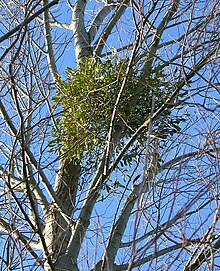
Back دبق Arabic دبق ARZ Öksəotu AZ بورک آغاجی AZB Амяла BE Амяла BE-X-OLD Имел Bulgarian Viscum Catalan Viscum CEB Jmelí Czech
| Viscum | |
|---|---|

| |
| Viscum album growing on a Populus species | |
| Scientific classification | |
| Kingdom: | Plantae |
| Clade: | Tracheophytes |
| Clade: | Angiosperms |
| Clade: | Eudicots |
| Order: | Santalales |
| Family: | Santalaceae |
| Genus: | Viscum L. |
| Type species | |
| Viscum album | |
| Species | |
|
See text | |
Viscum is a genus of about 70–100 species of mistletoes, native to temperate and tropical regions of Europe, Africa, Asia and Australasia.[1] Traditionally, the genus has been placed in its own family Viscaceae, but recent genetic research by the Angiosperm Phylogeny Group shows this family to be correctly placed within a larger circumscription of the sandalwood family, Santalaceae. Its name is the origin of the English word viscous, after the Latin viscum, a sticky bird lime made from the plants' berries.
They are woody, obligate hemiparasitic shrubs with branches 15–80 centimetres (5.9–31.5 in) long. Their hosts are woody shrubs and trees. The foliage is dichotomously or verticillately branching, with opposite pairs or whorls of green leaves which perform some photosynthesis (minimal in some species, notably V. nudum), but with the plant drawing its mineral and water needs from the host tree. Different species of Viscum tend to use different host species; most species are able to use several different host species.
The flowers are inconspicuous, greenish-yellow, 1–3 millimetres (0.039–0.118 in) diameter. The fruit is a berry, white, yellow, orange, or red when mature, containing one or more seeds embedded in very sticky juice; the seeds are dispersed when birds (notably the mistle thrush) eat the fruit, and remove the sticky seeds from the bill by wiping them on tree branches where they can germinate.
- ^ O'Neill, A. R.; Rana, S. K. (2019). "An ethnobotanical analysis of parasitic plants (Parijibi) in the Nepal Himalaya". Journal of Ethnobiology and Ethnomedicine. 12 (14): 14. doi:10.1186/s13002-016-0086-y. PMC 4765049. PMID 26912113.